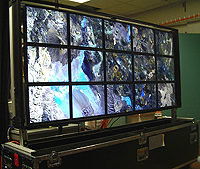The Personal GeoWall 2 (PG-2)
January 1st, 2004 - May 1st, 2004
Categories: Devices, Education, Visualization

About
GeoWall is an affordable PC / Mac / Linux 3D passive-stereo projection display developed by the University of Illinois at Chicago, Electronic Visualization Laboratory (EVL).
The GeoWall Consortium (www.geowall.org) was founded by the principals of this proposal to facilitate the adoption of this technology in the geoscience community. Within 2 years, over 250 GeoWalls have been built and over 20% of undergraduate, non-major Earth Science students in the United States use the GeoWall in their coursework. Moreover, GeoWalls are installed in elementary schools, middle schools, and museums such as the SciTech Museum in Aurora IL.
Whereas the GeoWall was designed to address the community’s need for 3D stereoscopic visualization, EVL recently developed GeoWall-2 to evaluate their need for screen resolution. GeoWall-2 is a tiled display built from an array of 5x3 LCD tiles and driven by a cluster of 9, 32-bit PCs (each PC driving 2 displays, and 1 extra PC as the master controller). GeoWall-2 was recently demonstrated at both the Supercomputing and AGU conferences in 2003. Various institutions, such as the Joint Oceanographic Institutions and the US Geological Survey’s EROS Data Center, displayed their datasets on the GeoWall-2.
To give individual geoscience researchers a GeoWall-2 system that can fit inside a small office, EVL have recently developed the Personal GeoWall 2 (PG-2). PG-2 is essentially a GeoWall-1 that has been enhanced with an extra multi-headed graphics card so that in addition to driving a passive stereo display, it can also simultaneously drive a 2x2 tiled LCD display. The PG-2 will be unveiled at the 4th annual GeoWall Consortium meeting held from May 10-11th 2004 at the Scripps Institution of Oceanography, in San Diego. The focus of the GeoWall Consortium in the next few years will be to develop visualization software for these high resolution display systems - for which there are few currently available on the commercial market.